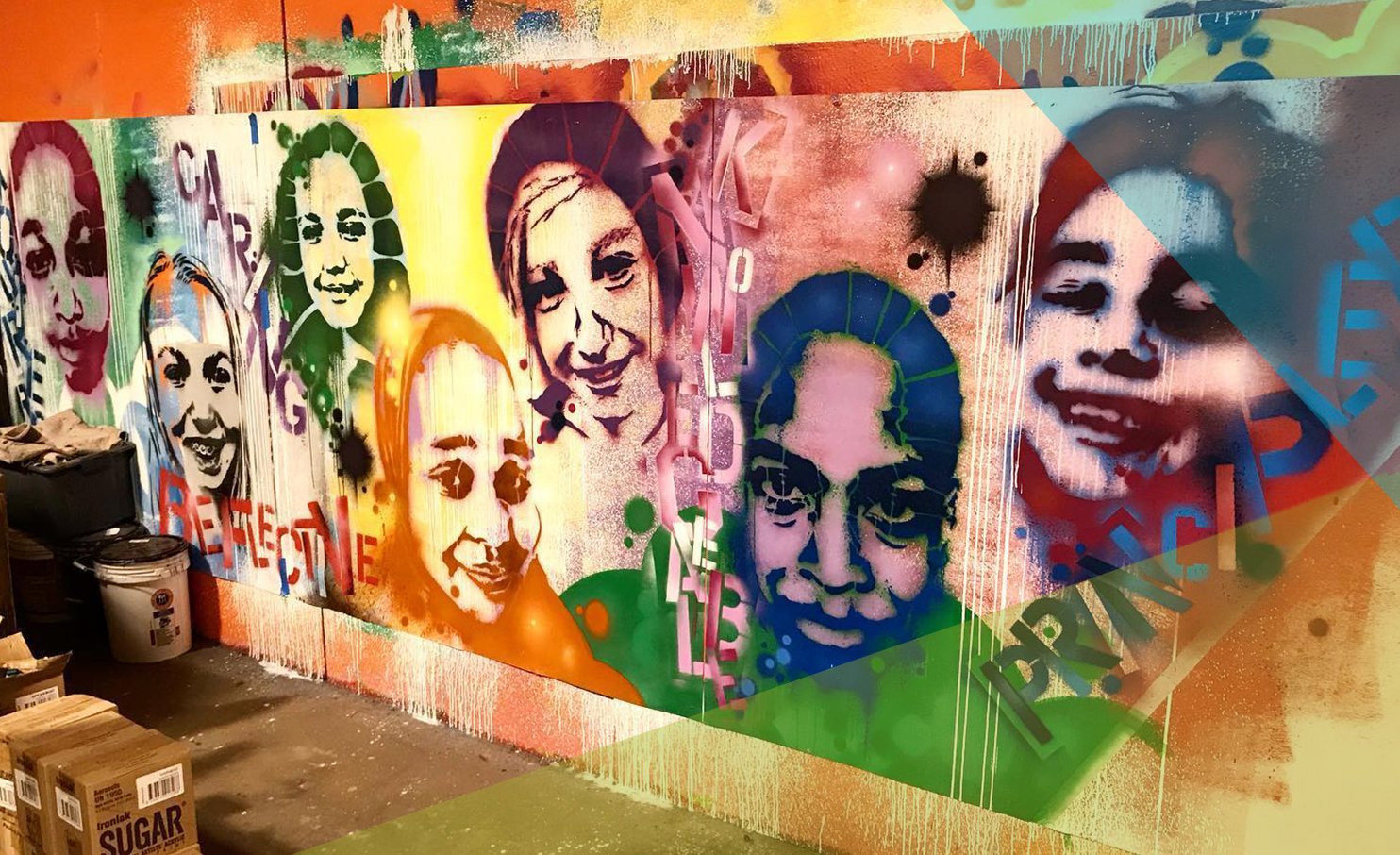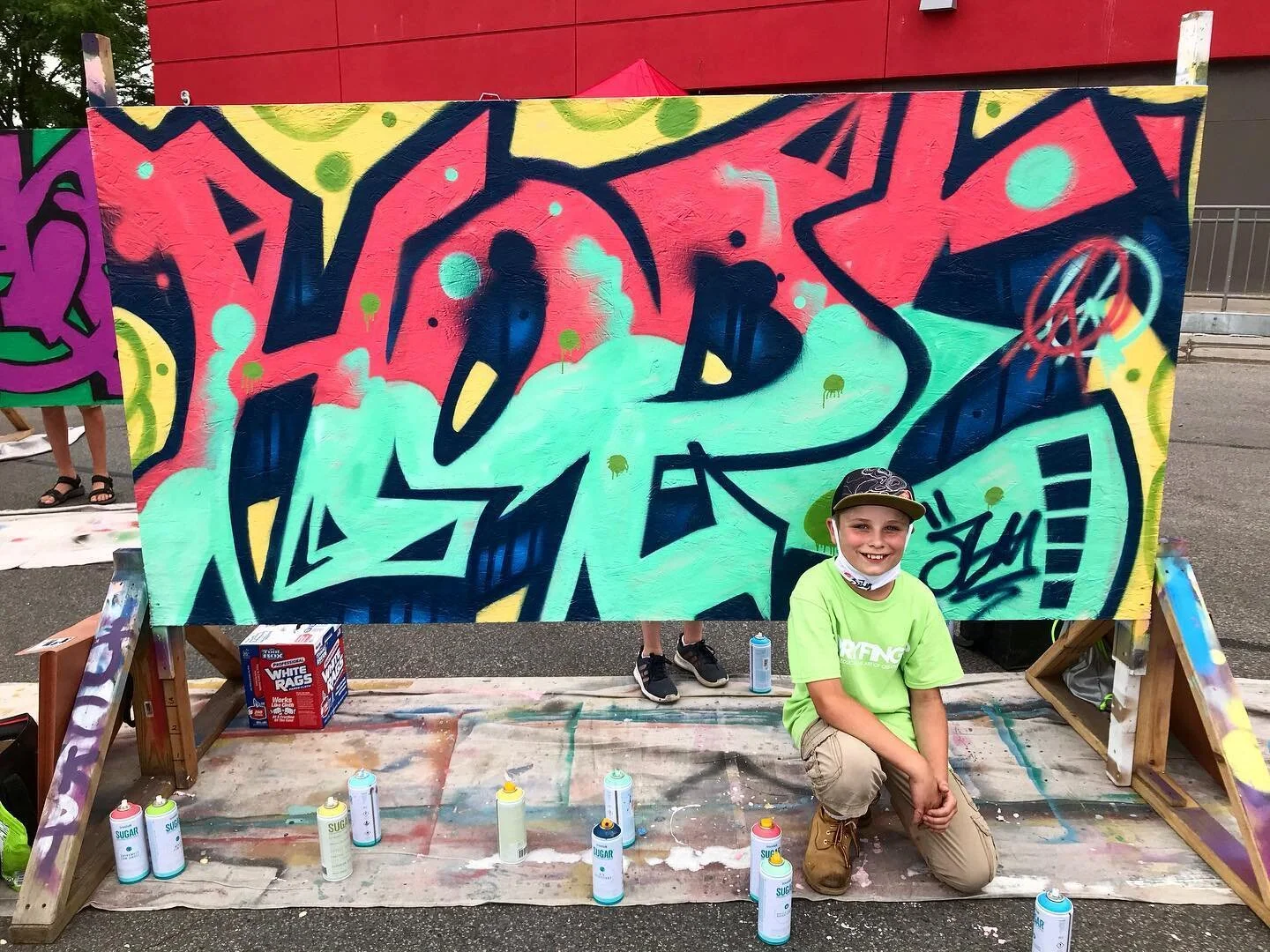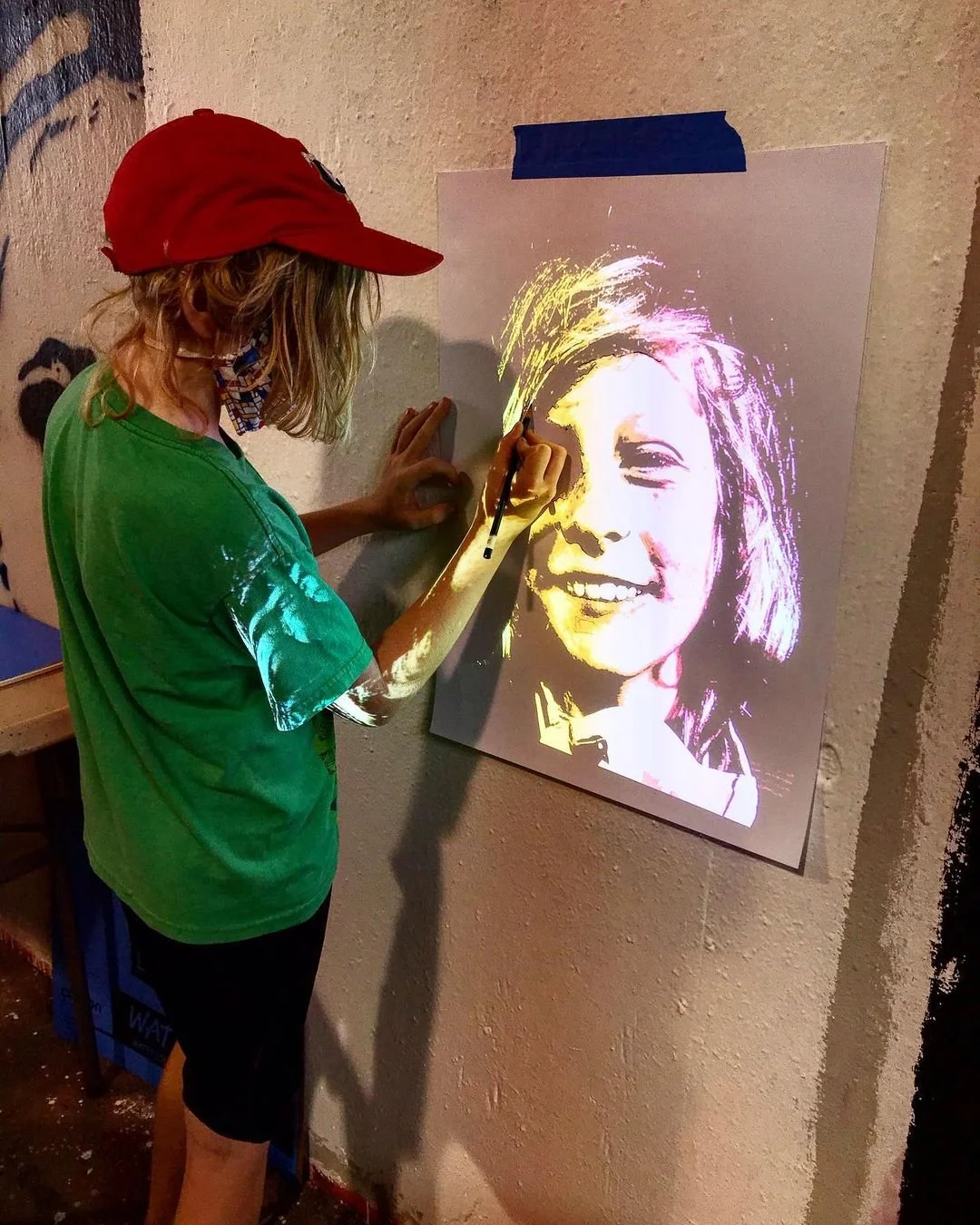SPRAYFiNGER founder takes a deep dive into the business of occupying space as an Artspace Immersion cohort member
May 10, 2023 | Arts & Cultural Affairs
Photo: SPRAYFiNGER student youth project.
SPRAYFiNGER® founder Peyton Scott Russell’s vision for a new creative space in North Minneapolis he can call home–for everyone.
The City of Minneapolis’ Arts & Cultural Affairs, Capacity Building for Creative Spaces grantee SPRAYFiNGER was one of ten creative enterprises selected for Artspace Immersion – a 12-month cohort program that builds organizational knowledge and capacity to plan for workspace needs.
Liz Pangerl, a marketing & communications consultant for Arts & Cultural Affairs interviewed Peyton Scott Russell, the founder, as well as artist and instructor at SPRAYFiNGER about his vision for a space in North Minneapolis; being part of an Artspace Immersion cohort; what spatial equity means to him; and his goals for amplifying graffiti as an art form. This article has been edited for length and clarity.
How did you hear about this grant opportunity?
Photo: SPRAYFiNGER students with their stenciled self-portraits.
Peyton: I had been looking for a better location for my program and the Capacity Building for Creative Spaces was one opportunity – so I applied and boom. We got it. And here we are.
You entered the program with an idea for a new space. Has that changed or evolved over the first half of the program?
Peyton: No. When I envision or get focused on something, I find ways to achieve my goals or help enhance them.
I've been in non-profit and community work 30 plus years. I’ve had to find space, create space, and move from one space to another, so some of this work isn’t foreign to me and some things aren’t in my wheelhouse at all. For example, the business aspect and administration – despite having learned by trial and error, I am at a point where I need a team. I need people to support my understanding of the process thoroughly, and people who can answer my questions correctly because I have very specific questions.
“It’s what I refer to as the ‘academics of space ownership,’ working with the city of Minneapolis, understanding codes, it’s all gritty stuff, the non-glorified things that go into occupying a space.” — Peyton
Can you share a bit about SPRAYFiNGER needs as relates to your vision for a space you can call home?
Peyton: It must have a feeling, there needs to be a familiarity to the space.
I spent my childhood years, on the south side of Minneapolis. I grew up near 38th and Chicago, close to Phelps Park. We played at the corner that is now internationally known. In tenth grade I moved to North Minneapolis and started high school. Post-graduation in ‘87, I moved to Chicago, and spent six, seven years there and then returned to north Minneapolis. I really feel that I came of age, and even an adult over north.
I started my community programs with art classes reaching out to northside residents and youth, so north is home for me and it needs a lot of community care and development, so I feel most useful there.
“Artspace Immersion is a program designed for arts and culture groups that contribute so much to our city, but often find that they don't have a space that meets their needs. The SPRAYFiNGER team has a beautiful vision for a future space, and we're thrilled to support their planning process as they work to make it a reality.”
– Anna Growcott, Vice President, Artspace Consulting
What does spatial equity mean for you?
Peyton: Ownership and access to more so everyone can be successful. But if we are all after the same funding streams, then that’s not real equity. The Artspace Immersion program – for me – is as an opportunity to experience a little peace for myself, so I turn around and help others by providing a space for youth, emerging artists, and early career and established artists. A space for growth and recognition, a place to spread one’s wings, a place to shine.
Having ownership is equity in a neighborhood. My program is about graffiti arts education. And that is a huge incredible leap forward for the culture and the craft of graffiti as an art form.
You’ve described this process for you as a spraying endeavor, can you elaborate further?
Photo: 2020 Juneteenth SPRAYFiNGER Graffiti Camp.
Peyton: I deal with street art in its positive application – graffiti – as an expressive form of art. In my programming, I teach how graffiti connects to community, to infrastructure and to communication. We have a space where we do classroom work, and training, and then the art form ultimately exists outside the walls, and that’s what brings people in. In the last decade graffiti as an art form has grown tremendously.
“People are finally understanding it as a legitimate expression, created in real time and in real space.” — Peyton
The debate is whether it is sanctioned or not. Being in a safe space opens the door to expression using creative lettering as art, without the negative connotations attached to it. Having a space that allows people to rise up and be expressive in this medium is also about equity.
How has this investment by the city impacted your work/vision?
Peyton: As an artist I’ve always looked for spaces that I can infuse with my own spirit, energy, and integrity. A space I can fix up and make my own, like an old warehouse that is rough but with plenty of character, even mystery.
Photo: SPRAYFiNGER student prepares a self-portrait stencil from a high contrast photograph.
And yet something completely different has already presented itself. A building that is ready to go, it’s not a fixer upper. It’s beautiful and a space that I’m very familiar with. “
The current owner has known me since high school, and all the things I’ve done. There’s trust and respect in our mutual relationship. I want to provide a service to the community of North Minneapolis. A space that reflects the arts, a space for people to enjoy, to be creative in, to sit and relax, to get to know each other, it’s all these things and more. We’ll move forward cautiously, simply because there are so many things that need to fall in place.
Would you take ownership of the building?
Peyton: Yes. I would become an instant landlord which isn’t something I had given much thought to. But having this level of responsibility means I have to get my head wrapped around this. The opportunities for a space like this are remarkable. Realistically, it’s hard to create in a compromised space. Most of the time they are never adequate, so this is an incredible find.
“I'm excited about inviting art educators, creating after-school and summer programming, and having multiple classes during the week, rather than just one class.” — Peyton
Should the city consider continuing this programming?
Peyton: Yes, there needs to be more, a lot more. This Artspace Immersion program gives our cohort access to deeper and heavier resources. And it’s possible for all of us to grow together as a community. And when I say community, I mean, everybody, I'm talking about the city, the state, the country, this community. My question is, why aren’t there more opportunities that would allow us all to prosper and benefit? I mean I am incredibly grateful, but so many of us doing this work are vying for the same dollars – dollars that aren’t sustainable. We all went through a traumatic period with the murder of George Floyd, and it brought awareness, the kind that wants to give back, but it’s not enough. So much more could happen, especially in Minnesota. As prolific as I am, I still struggle around funding, and sometimes just barely get by.
And yet, I am the exception. I have limitless ambition and drive, otherwise I would get swallowed up. I see familiar faces in my cohort — leaders doing the same thing I am doing — going after funding and fighting for it. We need a wider blanket of more, because it exists, it’s available and it should be much easier to access it.
You have a trip planned?
Peyton: Yes, the U.S. State Department is supporting my graffiti arts education program by inviting me to Jerusalem to work with Palestinians and Israelis on graffiti programming for two weeks. I’ll be collaborating with legendary New York pioneers to bring our love and communication of street art into Jerusalem, into communities. Street art exists there of course, but this is about reaching out internationally. We represent some of the founders of graffiti as an art form, so it’s a solidarity point. Graffiti in and of itself has a quality of impermanence to it. It’s ephemeral. It’s love. So, this is an incredible public relations opportunity for me and my colleagues with the U.S. State Department.
About SPRAYFiNGER
SPRAYFiNGER teaches graffiti unapologetically as an art form, offering a comprehensive curriculum designed to teach anyone – artist or not – the fundamentals of graffiti and street art. SPRAYFiNGER builds partnerships with artists, teachers, business owners, arts organizations, community leaders, parents, and students (youth to seniors) to address and discuss the culture, community, expression, and process of graffiti writing as an artistic concept. The program provides curricula, outlines, and techniques that merges language used by art teachers and street artists to deliver high-quality authentic Graffiti Arts instruction.
George Floyd portrait by Peyton Scott Russell, 38th and Chicago, Minneapolis, MN. Photo by L. Pangerl.
About Peyton Scott Russell
As a Bush Fellowship recipient, 2012-14, Peyton formed SPRAYFINGER, a program used for teaching, Graffiti: The Art of Creative Lettering, to youth, adults, seniors and the community at large. Russell earned a BFA from the School of the Arts Institute of Chicago in 1991. For more than three decades, Russell has been a professional artist and arts instructor.
On May 25, 2020, Russell along with the rest of the world witnessed the murder of George Floyd by Minneapolis police at the corner of 38th and Chicago in Minneapolis. Within days he returned to the corner of many of his childhood memories and with the help of studio mates erected what has now become a globally recognized iconic image, that of George Floyd’s face in graphic black and white, spray-painted on a 12 by 12 foot plywood surface. Russell recounts, “it was an act of protest on my part as a graffiti writer and street artist.”
SPRAYFiNGER® Website Facebook Instagram
Artspace Immersion
Stay in the loop by checking in on Arts & Cultural Affairs calendar of events.
Publisher's Note: The name, "The Office of Arts, Culture & the Creative Economy" has been updated on August 13, 2023 where it appeared within the content of this article to "Arts & Cultural Affairs" to reflect its new name as a department of the City of Minneapolis.






